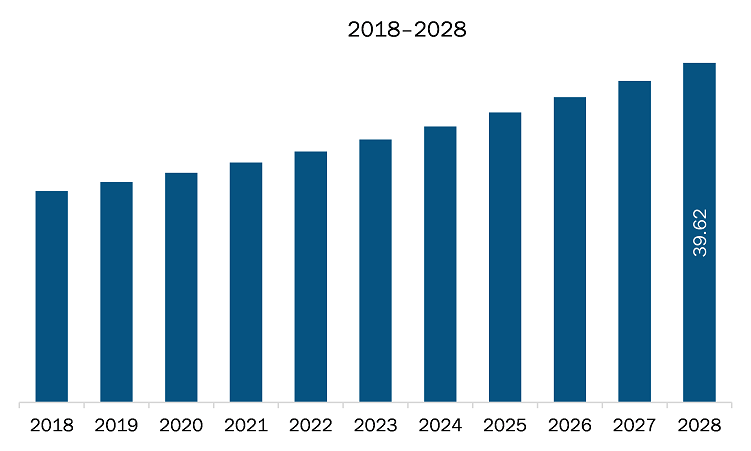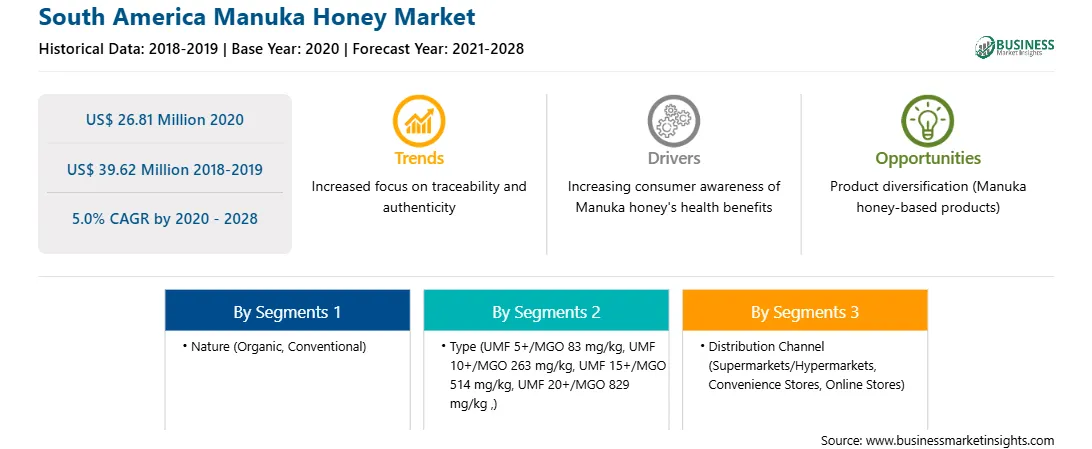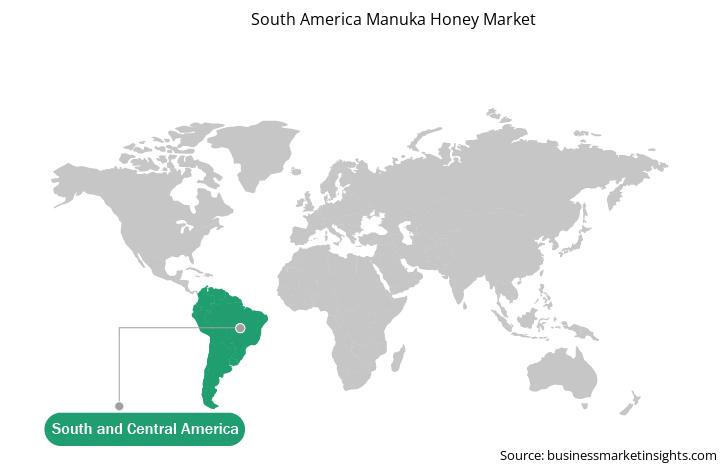The SAM region consists of several developed and developing economies, such as Brazil, Argentina, and the rest of South and Central America. The region is contributing to the growth of manuka honey in relation to the rising health consciousness among the consumers. Growing expenditure on nutrition and health, rising disposable income, and the health benefits associated with manuka honey are among the key factors driving the growth of the manuka honey market in South and Central America. Moreover, rising investments by major players to optimize the supply chain and improve operations are expected to boost the manuka honey market growth in the coming years.
Brazil has the highest number of COVID-19 cases, followed by Argentina, Chile, Peru, and Ecuador among others. The government of South and Central America has taken an array of actions to protect their citizens and contain COVID-19’s spread. It is anticipated that South America will face lower export revenues, both from the drop in commodity prices and reduction in export volumes, especially to China, Europe, and the U.S, which are important trade partners. Containment measures in several countries of South and Central America have reduced economic activity in the food and beverages sector for at least the next quarter, with a rebound once the epidemic is contained.Furthermore, the ongoing pandemic has drastically altered the status of the manuka honey industry and has negatively impacted the growth of the market. The COVID-19 outbreak has distorted operational efficiency and disrupted the value chains due to the sudden closure of national and international boundaries, creating revenue loss and damage. The disruptive value chain has had a negative impact on raw material supply, which, in turn, is impacting the growth of the manuka honey market. However, as the economies are planning to revive their operations, the demand for manuka honey is expected to rise globally. Although the focus over just-in-time production is another concerning factor hindering market growth. With the growing consciousness towards health amongst consumers and diversification of application bases in post-pandemic times, the demand for manuka honey is expected to take huge leaps.

Strategic insights for the South America Manuka Honey provides data-driven analysis of the industry landscape, including current trends, key players, and regional nuances. These insights offer actionable recommendations, enabling readers to differentiate themselves from competitors by identifying untapped segments or developing unique value propositions. Leveraging data analytics, these insights help industry players anticipate the market shifts, whether investors, manufacturers, or other stakeholders. A future-oriented perspective is essential, helping stakeholders anticipate market shifts and position themselves for long-term success in this dynamic region. Ultimately, effective strategic insights empower readers to make informed decisions that drive profitability and achieve their business objectives within the market.

| Report Attribute | Details |
|---|---|
| Market size in 2020 | US$ 26.81 Million |
| Market Size by 2028 | US$ 39.62 Million |
| Global CAGR (2020 - 2028) | 5.0% |
| Historical Data | 2018-2019 |
| Forecast period | 2021-2028 |
| Segments Covered |
By Nature
|
| Regions and Countries Covered | South and Central America
|
| Market leaders and key company profiles |
The geographic scope of the South America Manuka Honey refers to the specific areas in which a business operates and competes. Understanding local distinctions, such as diverse consumer preferences (e.g., demand for specific plug types or battery backup durations), varying economic conditions, and regulatory environments, is crucial for tailoring strategies to specific markets. Businesses can expand their reach by identifying underserved areas or adapting their offerings to meet local demands. A clear market focus allows for more effective resource allocation, targeted marketing campaigns, and better positioning against local competitors, ultimately driving growth in those targeted areas.

The manuka honey market in South America is expected to US$ 39.62 million by 2028 from US$ 26.81 million in 2020. The market is estimated to grow at a CAGR of 5.0% from 2020 to 2028. Researchers and pharmacists worldwide are working to discover the potentials of manuka honey in pharmaceutical formulations due to the improved functionalities and applicability of manuka honey. The importance of organic products has been understood in the wake of alarming health issues coupled with rising consciousness about organic certifications and preference for high-quality products. The antibacterial properties of manuka honey make it a perfect component for medicinal use. Moreover, it is used as a natural ointment for all kinds of injuries and has been recognized as a go-to virus fighter in an age of resistance to traditional antibiotics. Manuka honey medicinal products are available in the form of tubes, tablets, capsules, soft gels, and gummies, among others. These medicinal products can treat various health-related issues, such as prevention from acne, sinus, sore throat, and treatment of a broad spectrum of surgical and chronic wounds. Other advantages of manuka honey include clearing infections, clearing up blemishes on skin, helping heal cuts and scrapes, easing stomach aches, boosting the immune system, providing energy, and improving digestion. The manuka honey is possibly the most stimulating medical-grade products used in hospitals to skin infections and heal wounds, mainly those non-responsive to standard treatments such as bacteria that are resilient to antibiotics. Rising antibiotic resistance is currently one of the world's most prevailing human health issues. Consumer’s changing lifestyle, rising health concerns, increasing healthcare costs, and growing preference for a fit and active lifestyle are the key factors driving the demand for the manuka honey for medical purposes. Therefore, the robust application of manuka honey in almost all health conditions coupled with increasing consumer preference for honey to achieve an active and disease-free life, is anticipated to propel the demand for manuka honey in the coming years.
South America manuka honey market is segmented based on nature, type, and distribution channel Based on nature, the South America manuka honey market based on nature is segmented into organic and conventional. The conventional segment accounted for the highest share in the market in 2020 and organic segment is expected to be fastest growing during forecast period. Based on type, is segmented into UMF 5+/MGO 83 mg/kg (ppm), UMF 10+/MGO 263 mg/kg (ppm), UMF 15+/MGO 514 mg/kg (ppm), and UMF 20+/MGO 829 mg/kg (ppm). The UMF 15+/MGO 514 mg/kg (ppm) segment accounted for the highest share in 2020 and UMF 20+/MGO 829 mg/kg (ppm) segment is expected to be the fastest growing during forecast period. Based on distribution channel, the market is segmented into supermarkets/hypermarkets, convenience stores, online stores and others. The supermarket/hypermarket segment accounted for the highest share in 2020 and online store segment is expected to be the fastest growing during forecast period.
A few major primary and secondary sources referred to for preparing this report on manuka honey market in South America are company websites, annual reports, financial reports, national government documents, and statistical database, among others. Major companies listed in the report are 100% Pure New Zealand Honey; Arataki Honey; Comvita; Manuka Health; Oha Honey; Capilano Honey Ltd; Streamland; and Wedderspoon Organic.
The South America Manuka Honey Market is valued at US$ 26.81 Million in 2020, it is projected to reach US$ 39.62 Million by 2028.
As per our report South America Manuka Honey Market, the market size is valued at US$ 26.81 Million in 2020, projecting it to reach US$ 39.62 Million by 2028. This translates to a CAGR of approximately 5.0% during the forecast period.
The South America Manuka Honey Market report typically cover these key segments-
The historic period, base year, and forecast period can vary slightly depending on the specific market research report. However, for the South America Manuka Honey Market report:
The South America Manuka Honey Market is populated by several key players, each contributing to its growth and innovation. Some of the major players include:
The South America Manuka Honey Market report is valuable for diverse stakeholders, including:
Essentially, anyone involved in or considering involvement in the South America Manuka Honey Market value chain can benefit from the information contained in a comprehensive market report.